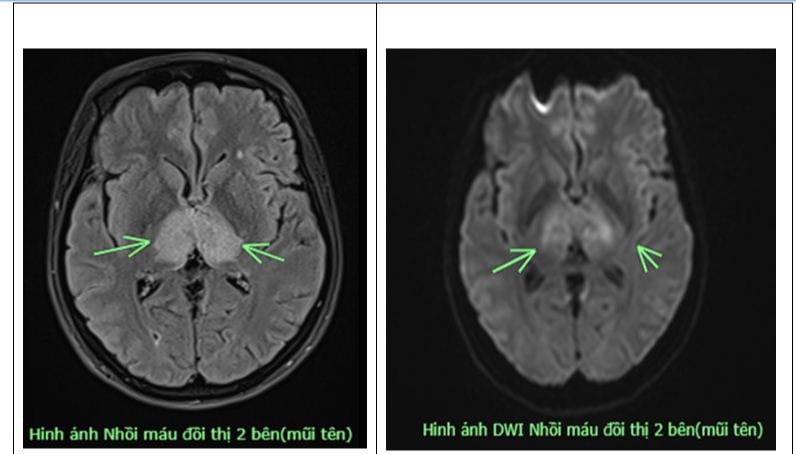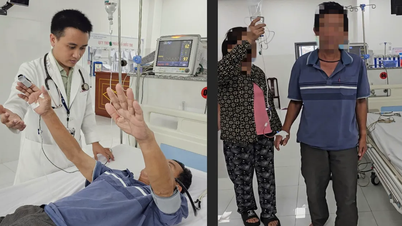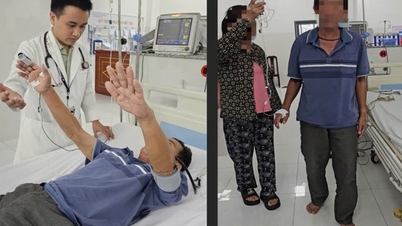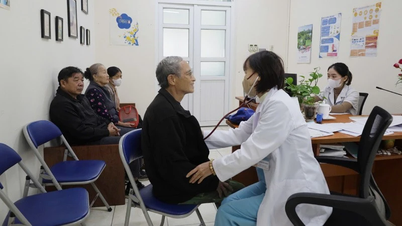According to information from Phu Tho Provincial General Hospital, the hospital recently received and treated a case of cerebral venous thrombosis.
The patient is a 38-year-old woman residing in Son Hung commune, Thanh Son district, Phu Tho province. Four days prior to admission, she experienced headaches and self-medicated at home, but without success.
Subsequently, the patient exhibited a slowed level of consciousness and was taken by their family to Phu Tho Provincial General Hospital with a Glasgow score of 13, breathing spontaneously, weakness in all four limbs, and sluggishness. Doctors ordered an MRI scan, which revealed cerebral infarction in both thalamic regions.

MRI scan of the patient's brain: Images showing bilateral thalamic infarction. (Photo courtesy of the hospital)
Recognizing that bilateral thalamic infarction was a rather unusual lesion, the doctors at the Stroke Center consulted and suspected a rare condition: cerebral venous thrombosis.
The patient was scheduled for a top-two-dimensional (TOP2D) MRI of the brain and a D-dimer coagulation test. The results confirmed a case of cerebral venous thrombosis.
The patient was diagnosed with: Right transverse sinus thrombosis, superior sagittal sinus thrombosis, and straight sinus thrombosis extending along the great cerebral vein and bilateral thalamic veins, with bilateral thalamic edema and right thalamic ischemia.
The patient was treated according to the protocol for cerebral venous thrombosis. Anticoagulant medication was used for treatment.
Following intensive treatment, the patient showed significant improvement. From a state of impaired consciousness (Glasgow score of 13), the patient is now fully conscious (Glasgow score of 15), has improved muscle strength in the limbs, and can now walk independently.
What is cerebral venous thrombosis?
According to Dr. Nguyen Anh Minh, a specialist at the Stroke Center of Phu Tho Provincial General Hospital, cerebral venous thrombosis is a type of stroke in which a blood clot occurs on the venous side of the cerebral circulation, leading to blockage of one or more cerebral veins and dural venous sinuses.
Cerebral venous thrombosis has an annual incidence rate ranging from 1.16 to 2.02/100,000, with a female/male ratio of 3:1, an average age of 37 years, and an incidence rate of only about 8% in those over 65 years old.
The disease is associated with transient factors such as oral contraceptives, pregnancy, postpartum period, infections, etc.; permanent factors include congenital blood clotting disorders, malignancies, bone marrow disorders, antiphospholipid syndrome, etc.
Dr. Minh explained that cerebral veins are responsible for draining blood from the brain's components back to the heart. When there is a blood clot in the cerebral veins or dural sinuses, it obstructs blood flow from brain tissue, leading to brain parenchymal damage (such as stroke), increased venous and capillary pressure, resulting in a breakdown of the blood-brain barrier, causing cerebral edema, increased intracranial pressure, and venous hemorrhage (a combination of infarction and hemorrhage).
The disease manifests in a wide variety of ways; symptoms may include headache, seizures, increased intracranial pressure (blurred vision, papilledema), and paralysis.
The 2017 ESO guidelines recommend cerebral venography (MRI) or cerebral venography (CT) to confirm the diagnosis of cerebral venous thrombosis. However, diagnosing cerebral venous thrombosis is quite challenging.
To make a diagnosis, the doctor must consider venous thrombosis because the clinical and paraclinical symptoms are often atypical and easily confused with other medical conditions or are easily overlooked.
Experts warn that cerebral venous thrombosis (VVT) is a dangerous and rare condition that is difficult to diagnose. Therefore, early diagnosis of VVT when patients are admitted to the hospital is of great importance for emergency care and treatment, helping to increase the chances of recovery for patients.
Source: https://giadinh.suckhoedoisong.vn/dau-dau-4-ngay-uong-thuoc-khong-do-nguoi-phu-nu-38-tuoi-mac-benh-nguy-hiem-o-nao-172240913122633453.htm


![[Photo] Prime Minister Pham Minh Chinh holds a phone call with the CEO of Russia's Rosatom Corporation.](/_next/image?url=https%3A%2F%2Fvphoto.vietnam.vn%2Fthumb%2F1200x675%2Fvietnam%2Fresource%2FIMAGE%2F2025%2F12%2F11%2F1765464552365_dsc-5295-jpg.webp&w=3840&q=75)

![[Photo] Closing Ceremony of the 10th Session of the 15th National Assembly](/_next/image?url=https%3A%2F%2Fvphoto.vietnam.vn%2Fthumb%2F1200x675%2Fvietnam%2Fresource%2FIMAGE%2F2025%2F12%2F11%2F1765448959967_image-1437-jpg.webp&w=3840&q=75)






















































![[OFFICIAL] MISA GROUP ANNOUNCES ITS PIONEERING BRAND POSITIONING IN BUILDING AGENTIC AI FOR BUSINESSES, HOUSEHOLDS, AND THE GOVERNMENT](https://vphoto.vietnam.vn/thumb/402x226/vietnam/resource/IMAGE/2025/12/11/1765444754256_agentic-ai_postfb-scaled.png)




















































Comment (0)